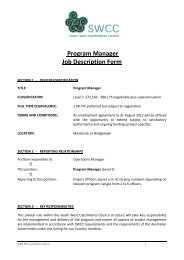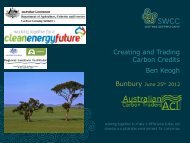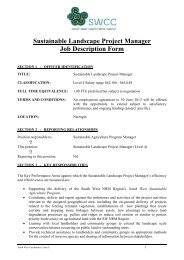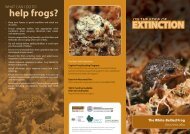Tender for the Programme - South West Catchments Council
Tender for the Programme - South West Catchments Council
Tender for the Programme - South West Catchments Council
You also want an ePaper? Increase the reach of your titles
YUMPU automatically turns print PDFs into web optimized ePapers that Google loves.
DRAFT<br />
<strong>South</strong> <strong>West</strong> Regional NRM Strategy – Ancillary Document<br />
CCCG 2007 Capes Catchment Management Strategy. Cape to Cape <strong>Catchments</strong> Group, Margaret<br />
River, WA. 62 pp.<br />
CCCG 2008 Boodjidup Brook Action Plan. Cape to Cape <strong>Catchments</strong> Group, Margaret River, WA. 72<br />
pp.<br />
This river action plan (RAP) contains a detailed description of <strong>the</strong> current health of <strong>the</strong> Boodjidup waterways in terms of fringing<br />
vegetation condition, weeds and erosion. It provides in<strong>for</strong>mation on current management issues, and recommends strategies to<br />
address <strong>the</strong>se issues. The report can be used to assist in prioritising actions in <strong>the</strong> catchment to protect and enhance <strong>the</strong> brook<br />
and provides background in<strong>for</strong>mation to aid decision-making <strong>for</strong> landholders, land managers and <strong>the</strong> community. Sections 1<br />
and 2 provide an introduction to <strong>the</strong> report and describe <strong>the</strong> study area. Section 3 discusses stream ecology. Section 4 outlines<br />
<strong>the</strong> methodology used in developing this action plan. Sections 5 and 6 detail <strong>the</strong> management issues identified and actions that<br />
can be taken to address <strong>the</strong>se issues. Section 7 contains maps of <strong>the</strong> study area showing <strong>for</strong>eshore condition rating, fencing<br />
status, weeds, erosion and o<strong>the</strong>r features. Specific management recommendations are detailed <strong>for</strong> each map in this section.<br />
This section may be a good starting point <strong>for</strong> landholders to identify management issues on <strong>the</strong>ir property. Section 8<br />
summarises <strong>the</strong> key actions and recommendations in <strong>the</strong> report. Appendices provide fur<strong>the</strong>r in<strong>for</strong>mation:<br />
List of local native plants species suitable <strong>for</strong> revegetation.<br />
List of local native plant species identified in <strong>the</strong> study area.<br />
Common weeds in <strong>the</strong> study area.<br />
Useful contacts <strong>for</strong> fur<strong>the</strong>r in<strong>for</strong>mation and assistance..<br />
CCCG 2011 2011-12 Action plan – Draft. Cape to Cape <strong>Catchments</strong> Group, Margaret River, WA. 7 pp.<br />
Sub-regional catchment group’s action plan <strong>for</strong> <strong>the</strong> year. Has useful in<strong>for</strong>mation, but no prioritisation of assets/threats etc. that<br />
would be of high relevance to strategy development.<br />
Commonwealth of Australia 2007 National Environmental Health Strategy 2007–2012. Department of<br />
Health and Ageing, Commonwealth Government, Canberra, ACT. 14 pp.<br />
Not of direct relevance to <strong>the</strong> strategy, but is cited as an example of <strong>the</strong> “risk assessment and management” approach used<br />
by <strong>the</strong> Commonwealth Government <strong>for</strong> strategy development. Being cited, it is included here.<br />
Cribb, J 2011 We ignore a deadly invader at our peril. From <strong>the</strong> web on 16 March 2011 on<br />
http://www.sciencealert.com.au/opinions/20112102-21868-2.html<br />
The invader in this case is <strong>the</strong> Java strain of <strong>the</strong> Asian bee, Apis cerana. At present <strong>the</strong> invading Asian bees are thought to<br />
occupy a foothold in a smallish region around Cairns, in far north Queensland. Compared with <strong>the</strong> well-established European<br />
honeybee (Apis mellifera), <strong>the</strong> Asian bee is a poor honey maker, swarms prolifically, and is capable of outcompeting and<br />
destroying colonies of both <strong>the</strong> European bee and native Australian bees. In <strong>the</strong> Solomon Islands recently it almost annihilated<br />
<strong>the</strong> honeybee industry, reducing it from 2000 hives to just five. On February 2, 2011, a decision was taken by a majority of<br />
State governments to end control ef<strong>for</strong>ts.<br />
Curtis, AL and EC Lefroy 2010 Beyond threat- and asset-based approaches to natural resource<br />
management in Australia. Australasian J Env Management 17(3):134-141<br />
Natural resource management (NRM) in Australia began as a series of campaigns against specific threats to agricultural and<br />
pastoral production, with war progressively declared on soil erosion, introduced pests and dryland salinity. Critiques of NRM<br />
programs in <strong>the</strong> 1990s coincided with a shift towards an asset-based approach. This approach emphasises <strong>the</strong> need <strong>for</strong> public<br />
investment to be focused on those parts of <strong>the</strong> landscape of high value, ra<strong>the</strong>r than defending large areas against broad-scale<br />
threats. The asset-based approach is more strategic, but runs <strong>the</strong> risk of sacrificing effectiveness <strong>for</strong> efficiency by overlooking<br />
<strong>the</strong> large-scale biophysical and social processes that underpin <strong>the</strong> viability of discrete assets. Fur<strong>the</strong>r, <strong>the</strong> asset-based<br />
approach fails to sufficiently acknowledge <strong>the</strong> importance of engaging and building <strong>the</strong> human, social and cultural capital<br />
required to underpin longterm environmental management. A condition-based approach to NRM is proposed that builds on <strong>the</strong><br />
best of <strong>the</strong> threat-based and asset-based approaches by setting targets based on environmental processes ra<strong>the</strong>r than<br />
perceptions of ideal states; borrowing systematic approaches to assessing value and condition from conservation planning; and<br />
investing in <strong>the</strong> social, economic, human and cultural capital required to support lasting change.<br />
Davis, MA, MK Chew, RJ Hobbs, AE Lugo, JJ Ewel, GJ Vermeij, JH Brown, ML Rosenzweig, MR<br />
Gardener, SP Carroll, K Thompson, STA Pickett, JC Stromberg, P Del Tredici, KN Suding, JG<br />
Ehrenfeld, JP Grime, J Mascaro and JC Briggs 2011 Don't judge species on <strong>the</strong>ir origins. Nature<br />
474:153-4<br />
The authors argue against <strong>the</strong> nativism perspective -- native species equals good, non-native species equals bad – which<br />
dominates conservation ef<strong>for</strong>ts. Many ecologists now believe it is time to rethink this, i.e. need to consider outcomes and<br />
impacts of an organism on an environment ra<strong>the</strong>r than focus on native origins. Scientific studies show that while some<br />
introduced species have negative impacts, it is not always <strong>the</strong> case, and “We need to consider <strong>the</strong> impact of <strong>the</strong>se terms”.<br />
Electronic version not available.<br />
DEC and Water and Rivers Commission 1997, Wetlands conservation policy <strong>for</strong> <strong>West</strong>ern Australia /<br />
Government of <strong>West</strong>ern Australia The Government, [Perth, W.A.] : 23pp.<br />
9






